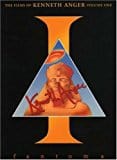 The Complete Magick Lantern Cycle
The Complete Magick Lantern Cycle
Kenneth Anger made films the way he thought they should look, illuminating some the most prohibited subject matter of his time. His apathetic attitude towards narrative drive and general disinterest in Hollywood’s opinion of him made him a founding father of American Underground and Queer Cinema, influencing Stan Brakhage, Andy Warhol and Martin Scorsese to name a few. Hollywood has a way of objectifying people yet personifying objects, and Anger does the opposite. In these early works, which are flooded with images of the Occult, homoeroticism and dark subcultural references spanning over three decades, Anger’s embrace of a chaotic narrative underscores his themes of helplessness in the face of nature.
America’s bipolar relationship with sexuality has historically aroused a war between a puritan agenda, total deviance, and everything in between. Anger is blessed in his ability to fetishize masculinity, and his work, like the archetypal daemons that haunt it, is neither good nor evil, but a balance of both. He made his first film, Fireworks, in 1947 when his parents were out of town. It was based on a dream he had which was influenced by images he’d seen in the news of the 1943 zoot suit riots. In Fireworks Anger plays the dreamer, at the mercy of several sailors, one of whom at the film’s end lights a roman candle in the crotch of his pants. At the film’s first screening Alfred Kinsey bought a copy to show to his students. While the majority of post WW2 films are clouded by a sanitized veneer of culture, or are bursting with subtext like the many noirs that would later reach cult status, Fireworks is an undiluted work of instinct and eroticism, touched by themes of sex magick. Anger gestures towards the fallible line between hetero and homosexuality, and how powerless we are to our environment and our primitive nature, conscious of it or not. His films suggest that we cannot control sex or nature, that they are one in the same.
In Eaux d’Artifice (1953) Anger films the gardens of the Villa d’Este in Tivoli, Italy, built in the sixteenth century and all functioning through gravity. He films a dwarf named Carmila, introduced to him by Fellini, who is adorned in exquisite period dress with a wispy feathered headpiece. His intention in casting her was for the gardens to appear larger, and he spends most of his time focused on long shots of Carmila, capturing her voyeuristically, or filming the water droplets at various speeds, isolating them in sparkling sunlight. As one of the stairways floods, Carmila descends under shadowy trees, water rushing underneath her and patches of light catching her feathers. Anger used heavy red filters and scored the film to Vivaldi’s four seasons, editing it to the music, much like he edited his actress to her environment. Clara Bow regarded Eau D’Artifice as Anger’s sexiest work, and it lives up to this through its celebration of water and the hypnotic shots of light and reflection. His ability to transition from classically beautiful subjects and environments and satanic rituals, yet maintain a cohesive body of work, proves evident one can make films the way they want to, if they truly are invested in their material.
Anger’s choice to film in the moment and figure it out later was what inspired Andy Warhol. While in New York, he met a pack of bikers at Coney Island, and asked if he could film them. The final result was the gay cult masterpiece Scorpio Rising. With a few tungsten lights and 16 mm film, Anger transformed a bunch of straight bikers from Brooklyn into gay icons. He staged nothing, even the scenes of a biker named Scorpio, shirtless in white jeans and a cap lying in bed surrounded James Dean Posters, and huge jars of pure methamphetamine. As Scorpio takes a snort of meth, the noose he’s fashioned above his bed sways behind him while he loads his gun. By incorporating popular songs like Bobby Vinton’s Blue Velvet and Ricky Nelson’sFools Rush In among many, Anger infuses the images with strange emotion; he frees the music from its intended purpose and manufactures a sensory result. During a Halloween party Anger crashes, the biker’s exclude their girlfriends from the spotlight, parading around, some nude, causing the film to come across much queerer than it may have otherwise been. And in a blessing from the gods of irony, while Anger was editing back in LA, a film reel intended for a nearby Sunday school called “Last Journey to Jerusalem” was delivered to his doorstep. He considered it a serendipitous occurrence, cutting scenes from it into Scorpio Rising. When the Lutheran Church tried to sue him, he scolded them for showing their students such bad films.
The forces of nature, directly linked to sex, are something Anger has always approached casually. The hedonistic rituals in films like Invocation of My Demon Brother and Lucifer Risingdon’t seem to be harming anybody, and perhaps elements of the Occult, like its worship of nature, could do a planet experiencing massive destruction to the environment a solid. The polarities of Satanism and Pentecostal Christianity seem oddly comparable in their extremities and aspects of spiritual oblivion, but which is doing more damage? Kenneth Anger is a filmmaker that is seen and talked about rarely, and his influences can be seen everywhere. Perhaps what’s so monumental about these works are that they signal the commencement of an era, and document an artist possessed by fearlessness and an unadulterated desire to project exactly what he sees.
